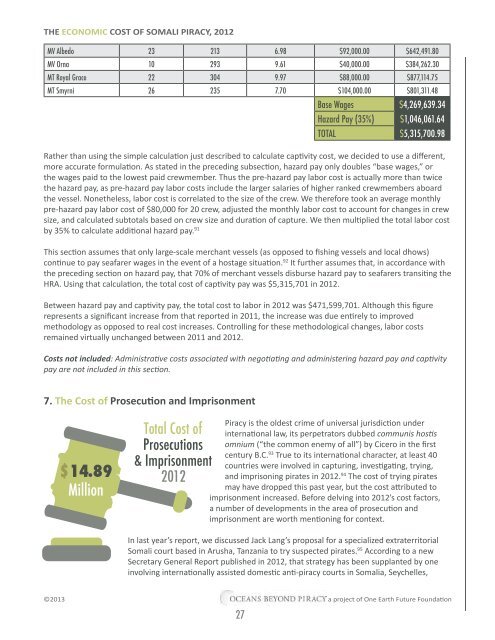You also want an ePaper? Increase the reach of your titles
YUMPU automatically turns print PDFs into web optimized ePapers that Google loves.
THE ECONOMIC COST OF SOMALI PIRACY, 2012<br />
MV Albedo 23 213 6.98 $92,000.00 $642,491.80<br />
MV Orna 10 293 9.61 $40,000.00 $384,262.30<br />
MT Royal Grace 22 304 9.97 $88,000.00 $877,114.75<br />
MT Smyrni 26 235 7.70 $104,000.00 $801,311.48<br />
Base Wages $4,269,639.34<br />
Hazard Pay (35%) $1,046,061.64<br />
TOTAL $5,315,700.98<br />
Rather than using the simple calculation just described to calculate captivity cost, we decided to use a different,<br />
more accurate formulation. As stated in the preceding subsection, hazard pay only doubles “base wages,” or<br />
the wages paid to the lowest paid crewmember. Thus the pre-hazard pay labor cost is actually more than twice<br />
the hazard pay, as pre-hazard pay labor costs include the larger salaries of higher ranked crewmembers aboard<br />
the vessel. Nonetheless, labor cost is correlated to the size of the crew. We therefore took an average monthly<br />
pre-hazard pay labor cost of $80,000 for 20 crew, adjusted the monthly labor cost to account for changes in crew<br />
size, and calculated subtotals based on crew size and duration of capture. We then multiplied the total labor cost<br />
by 35% to calculate additional hazard pay. 91<br />
This section assumes that only large-scale merchant vessels (as opposed to fishing vessels and local dhows)<br />
continue to pay seafarer wages in the event of a hostage situation. 92 It further assumes that, in accordance with<br />
the preceding section on hazard pay, that 70% of merchant vessels disburse hazard pay to seafarers transiting the<br />
HRA. Using that calculation, the total cost of captivity pay was $5,315,701 in 2012.<br />
Between hazard pay and captivity pay, the total cost to labor in 2012 was $471,599,701. Although this figure<br />
represents a significant increase from that <strong>report</strong>ed in 2011, the increase was due entirely to improved<br />
methodology as opposed to real cost increases. Controlling for these methodological changes, labor costs<br />
remained virtually unchanged between 2011 and 2012.<br />
Costs not included: Administrative costs associated with negotiating and administering hazard pay and captivity<br />
pay are not included in this section.<br />
7. The Cost of Prosecution and Imprisonment<br />
$14.89<br />
Million<br />
Total Cost of<br />
Prosecutions<br />
& Imprisonment<br />
2012<br />
<strong>Piracy</strong> is the oldest crime of universal jurisdiction under<br />
international law, its perpetrators dubbed communis hostis<br />
omnium (“the common enemy of all”) by Cicero in the first<br />
century B.C. 93 True to its international character, at least 40<br />
countries were involved in capturing, investigating, trying,<br />
and imprisoning pirates in 2012. 94 The cost of trying pirates<br />
may have dropped this past year, but the cost attributed to<br />
imprisonment increased. Before delving into 2012’s cost factors,<br />
a number of developments in the area of prosecution and<br />
imprisonment are worth mentioning for context.<br />
In last year’s <strong>report</strong>, we discussed Jack Lang’s proposal for a specialized extraterritorial<br />
Somali court based in Arusha, Tanzania to try suspected pirates. 95 According to a new<br />
Secretary General Report published in 2012, that strategy has been supplanted by one<br />
involving internationally assisted domestic anti-piracy courts in Somalia, Seychelles,<br />
©2013<br />
27<br />
a project of One Earth Future Foundation


